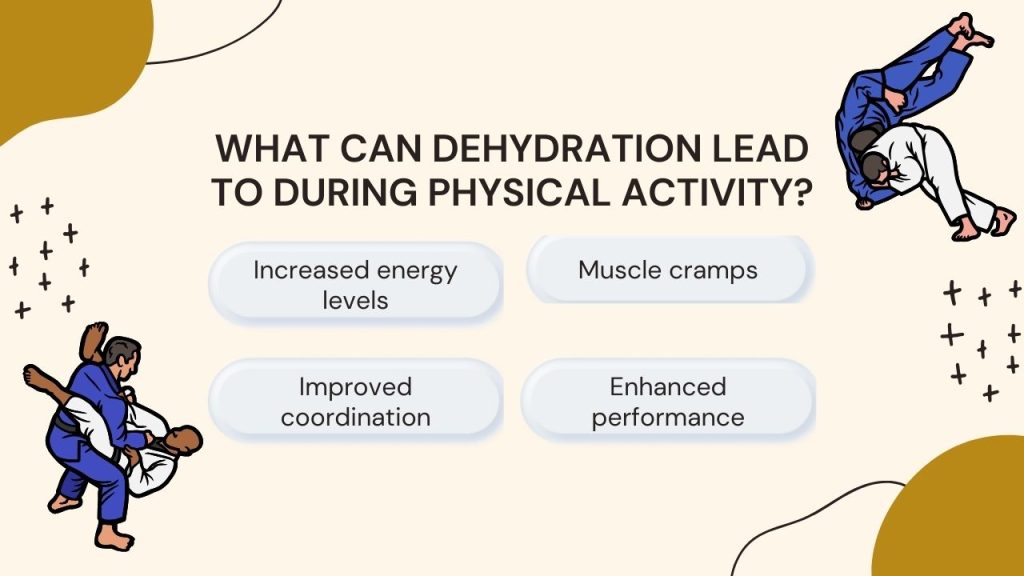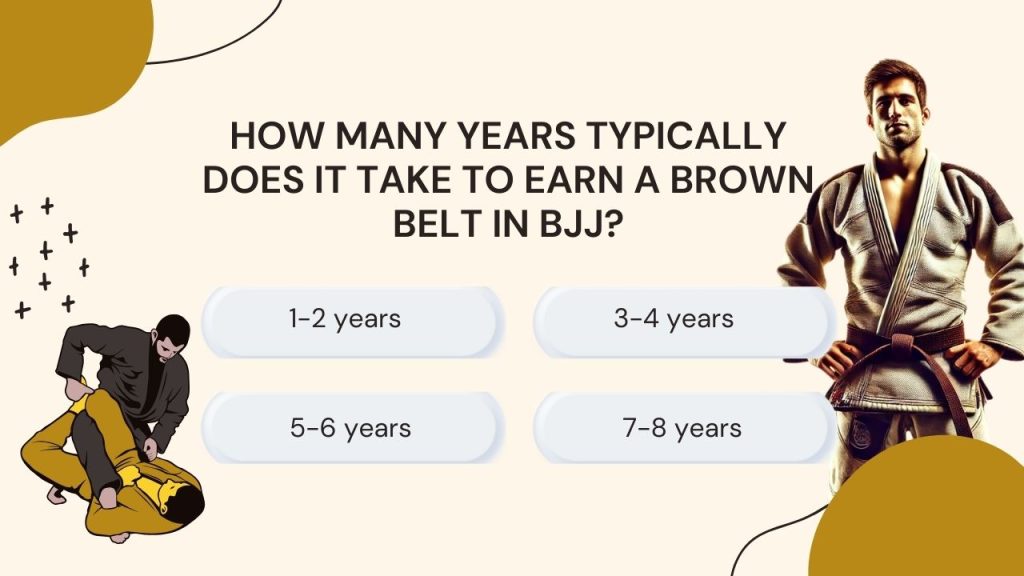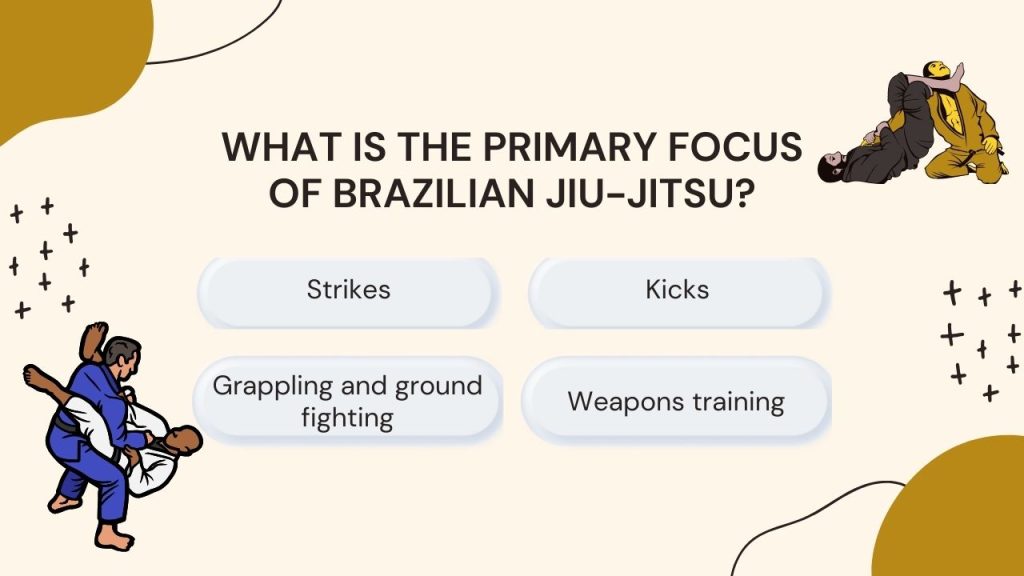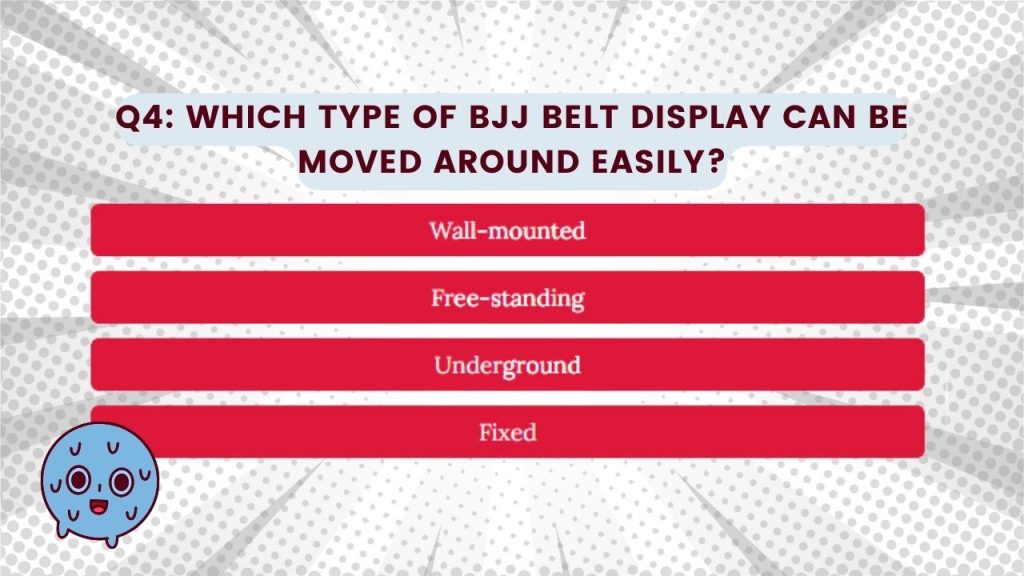
Get ready for the Ultimate IBJJF Weight and Age Divisions Quiz! Test your knowledge of the International Brazilian Jiu-Jitsu Federation’s age and weight divisions, competition rules, and more.
Let’s see how well you know the structure that shapes worldwide competition.
IBJJF Divisions Quiz
- Q1: At what age does the IBJJF’s Juvenile division start?
- Q2: What is the maximum age for an athlete to compete in the IBJJF Adult division?
- Q3: Which category follows the Juvenile division in IBJJF competitions?
- Q4: What is the age range for the Masters 1 division in IBJJF tournaments?
- Q5: How many Masters divisions are there in IBJJF tournaments?
- Q6: Which IBJJF division is suitable for a 41-year-old competitor?
- Q7: What is the youngest division in IBJJF tournaments?
- Q8: Which IBJJF division does not restrict competitors by weight?
- Q9: What is the difference in allowed Gi weight between Juvenile and Adult male competitors?
- Q10: How often does IBJJF update its division rules and regulations?
- Q11: What is the age requirement for the Masters 7 division in IBJJF tournaments?
- Q12: In which division would a 9-year-old competitor participate in IBJJF tournaments?
- Q13: What is the primary purpose of having age divisions in IBJJF tournaments?
- Q14: Which weight division allows competitors of any weight to participate in IBJJF tournaments?
- Q15: How does the IBJJF classify competitors in its tournaments?
- Q16: At what age can competitors start participating in the master divisions of IBJJF tournaments?
- Q17: What is the highest age-specific division for youth in IBJJF tournaments before reaching the Juvenile division?
- Q18: What IBJJF division is designated for children aged 5 years old?
- Q19: Which division in IBJJF tournaments is designed explicitly for competitors over 50 years old?
- Q20: What are the age limits for the Juvenile II division in IBJJF tournaments?
- Q21: Which division would a 35-year-old black belt compete in at an IBJJF tournament?
- Q22: What is the youngest Masters division in IBJJF tournaments?
- Q23: What is the IBJJF age division for competitors who are 10 years old?
- Q24: At what minimum age can competitors participate in the IBJJF Adult division?
- Q25: Which Masters division is for competitors aged 46-50 years old?
- Q26: What is the age group for Pee Wee I in IBJJF tournaments?
- Q27: In which division would a 56-year-old competitor participate in IBJJF tournaments?
- Q28: Which division accommodates the oldest competitors in IBJJF tournaments?
- Q29: What is the IBJJF division for children aged 8 years old?
- Q30: How are competitors classified in IBJJF tournaments besides age?
- Q31: Which division is directly below Juvenile in the IBJJF age divisions?
- Q32: What is the primary consideration for separating competitors into different weight divisions in IBJJF tournaments?
- Q33: What belt color marks the beginning of adult rank divisions in IBJJF tournaments?
- Q34: At what age can children start competing in IBJJF tournaments?
- Q35: Which Masters division is for competitors aged over 60?
- Q36: How many age divisions exist for youth under 18 in IBJJF tournaments?
- Q37: What IBJJF division would a 40-year-old blue belt compete in?
- Q38: In IBJJF, what is the upper age limit for the Teen divisions?
- Q39: What is required for a competitor to move from one rank division to another in IBJJF tournaments?
- Q40: Which age division in IBJJF tournaments has no upper age limit?
- Conclusion
Q1: At what age does the IBJJF’s Juvenile division start?
- A) 14 years old
- B) 16 years old
- C) 18 years old
- D) 21 years old
Answer: B) 16 years old
The Juvenile division in IBJJF starts at 16 years old, providing a platform for teenagers to compete.
Q2: What is the maximum age for an athlete to compete in the IBJJF Adult division?
- A) 29 years old
- B) 30 years old
- C) 32 years old
- D) 35 years old
Answer: A) 29 years old
The Adult division is open to athletes aged 18 to 29.
Q3: Which category follows the Juvenile division in IBJJF competitions?
- A) Adult
- B) Masters
- C) Teen
- D) Senior
Answer: A) Adult
After juveniles, competitors move into the adult category, starting at 18.
Q4: What is the age range for the Masters 1 division in IBJJF tournaments?
- A) 30-35 years old
- B) 36-40 years old
- C) 25-30 years old
- D) 40-45 years old
Answer: A) 30-35 years old
Masters 1 division is for competitors aged 30 to 35 years old.
Q5: How many Masters divisions are there in IBJJF tournaments?
- A) 5
- B) 6
- C) 7
- D) 8
Answer: C) 7
There are seven Masters divisions, from Masters 1 through Masters 7.
Q6: Which IBJJF division is suitable for a 41-year-old competitor?
- A) Masters 2
- B) Masters 3
- C) Masters 4
- D) Masters 5
Answer: B) Masters 3
The Masters 3 division is for competitors aged 41 to 45 years old.
Q7: What is the youngest division in IBJJF tournaments?
- A) Pee Wee I
- B) Mighty Mite I
- C) Junior I
- D) Teen I
Answer: B) Mighty Mite I
The Mighty Mite I division is for children who are 4 years old.
Q8: Which IBJJF division does not restrict competitors by weight?
- A) Rooster
- B) Open class
- C) Light
- D) Heavy
Answer: B) Open class
The Open class division does not restrict competitors by weight.
Curious about IBJJF weight classes? Explore our detailed breakdown of the IBJJF weight classes and sharpen your understanding of how these divisions shape the competition landscape. Check out the article now!
Q9: What is the difference in allowed Gi weight between Juvenile and Adult male competitors?
- A) 1.5 kg
- B) 2 kg
- C) 2.5 kg
- D) No difference
Answer: D) No difference
The allowed Gi weight is the same for Juvenile and Adult male competitors; weight classifications adjust for the Gi weight similarly across all age groups.
Q10: How often does IBJJF update its division rules and regulations?
- A) Annually
- B) Biannually
- C) Every five years
- D) Only when necessary
Answer: A) Annually
IBJJF typically updates its rules and regulations annually to reflect changes in the sport and maintain fairness.
Q11: What is the age requirement for the Masters 7 division in IBJJF tournaments?
- A) 60 years old
- B) 65 years old
- C) 70 years old
- D) 61 years old and older
Answer: D) 61 years old and older
Masters 7 is for athletes who are 61 years old and older.
Q12: In which division would a 9-year-old competitor participate in IBJJF tournaments?
- A) Mighty Mite III
- B) Pee Wee III
- C) Junior I
- D) Teen I
Answer: B) Pee Wee III
A 9-year-old would compete in the Pee Wee III division.
Q13: What is the primary purpose of having age divisions in IBJJF tournaments?
- A) To increase competition
- B) To ensure safety and fairness
- C) To limit the number of participants
- D) To make the tournaments shorter
Answer: B) To ensure safety and fairness
Age divisions help ensure safety and fairness by grouping competitors with similar physical and developmental characteristics.
Q14: Which weight division allows competitors of any weight to participate in IBJJF tournaments?
- A) Light
- B) Middle
- C) Open class
- D) Super Heavy
Answer: C) Open class
The Open class division allows competitors of any weight to participate.
Q15: How does the IBJJF classify competitors in its tournaments?
- A) By age and weight only
- B) By rank only
- C) By age, weight, and rank
- D) By age and experience
Answer: C) By age, weight, and rank
IBJJF classifies competitors based on age, weight, and rank to ensure fair and competitive matches.
Q16: At what age can competitors start participating in the master divisions of IBJJF tournaments?
- A) 29 years old
- B) 30 years old
- C) 35 years old
- D) 40 years old
Answer: B) 30 years old
Competitors can start participating in the Masters divisions at age 30.
Q17: What is the highest age-specific division for youth in IBJJF tournaments before reaching the Juvenile division?
- A) Teen III
- B) Junior III
- C) Pee Wee III
- D) Mighty Mite III
Answer: A) Teen III
Teen III is the highest youth division before reaching the Juvenile division.
Curious about IBJJF age divisions? Explore our detailed guide and deepen your understanding of the age-based categories in Brazilian Jiu-Jitsu competitions. Whether you’re preparing to compete or love to learn, this article has everything you need. Check it out now!
Q18: What IBJJF division is designated for children aged 5 years old?
- A) Mighty Mite I
- B) Mighty Mite II
- C) Pee Wee I
- D) Pee Wee II
Answer: B) Mighty Mite II
Mighty Mite II is for children aged 5 years old.
Q19: Which division in IBJJF tournaments is designed explicitly for competitors over 50 years old?
- A) Masters 4
- B) Masters 5
- C) Masters 6
- D) Masters 7
Answer: B) Masters 5
Masters 5 is specifically designed for competitors aged 51-55 years old.
Q20: What are the age limits for the Juvenile II division in IBJJF tournaments?
- A) 15-16 years old
- B) 16-17 years old
- C) 17-18 years old
- D) 18-19 years old
Answer: B) 16-17 years old
The Juvenile II division is for competitors aged 16 to 17 years old.
Q21: Which division would a 35-year-old black belt compete in at an IBJJF tournament?
- A) Adult
- B) Masters 1
- C) Masters 2
- D) Masters 3
Answer: B) Masters 1
A 35-year-old black belt would compete in the Masters 1 division.
Q22: What is the youngest Masters division in IBJJF tournaments?
- A) Masters 1
- B) Masters 2
- C) Masters 3
- D) Masters 4
Answer: A) Masters 1
Masters 1 is the youngest Masters division, starting at age 30.
Q23: What is the IBJJF age division for competitors who are 10 years old?
- A) Pee Wee III
- B) Junior I
- C) Junior II
- D) Mighty Mite III
Answer: B) Junior I
The Junior I division is for competitors who are 10 years old.
Q24: At what minimum age can competitors participate in the IBJJF Adult division?
- A) 16 years old
- B) 17 years old
- C) 18 years old
- D) 19 years old
Answer: C) 18 years old
Competitors can participate in the Adult division starting at 18 years old.
Q25: Which Masters division is for competitors aged 46-50 years old?
- A) Masters 3
- B) Masters 4
- C) Masters 5
- D) Masters 6
Answer: B) Masters 4
Masters 4 is for competitors aged 46-50 years old.
Q26: What is the age group for Pee Wee I in IBJJF tournaments?
- A) 5 years old
- B) 6 years old
- C) 7 years old
- D) 8 years old
Answer: C) 7 years old
Pee Wee I is for competitors who are 7 years old.
Q27: In which division would a 56-year-old competitor participate in IBJJF tournaments?
- A) Masters 5
- B) Masters 6
- C) Masters 7
- D) Masters 4
Answer: B) Masters 6
Masters 6 is for competitors aged 56-60 years old.
Q28: Which division accommodates the oldest competitors in IBJJF tournaments?
- A) Senior
- B) Masters 6
- C) Masters 7
- D) Legends
Answer: C) Masters 7
Masters 7 is for competitors aged 61 years old and older, accommodating the oldest competitors.
Q29: What is the IBJJF division for children aged 8 years old?
- A) Mighty Mite III
- B) Pee Wee II
- C) Pee Wee III
- D) Junior I
Answer: B) Pee Wee II
Pee Wee II is for children aged 8 years old.
Q30: How are competitors classified in IBJJF tournaments besides age?
- A) By weight and gender
- B) By belt color and weight
- C) By belt color and experience
- D) By weight only
Answer: B) By belt color and weight
Besides age, competitors in IBJJF tournaments are classified by their belt color and weight.
Q31: Which division is directly below Juvenile in the IBJJF age divisions?
- A) Teen III
- B) Junior III
- C) Pee Wee III
- D) Mighty Mite III
Answer: A) Teen III
Teen III is the division directly below Juvenile for athletes transitioning into more competitive brackets.
Q32: What is the primary consideration for separating competitors into different weight divisions in IBJJF tournaments?
- A) Age
- B) Belt rank
- C) Physical strength
- D) Body weight
Answer: D) Body weight
Body weight is the primary consideration when separating competitors into different weight divisions in IBJJF tournaments.
Q33: What belt color marks the beginning of adult rank divisions in IBJJF tournaments?
- A) White
- B) Blue
- C) Purple
- D) Brown
Answer: B) Blue
Following the white belt level, the blue belt marks the beginning of adult rank divisions in IBJJF tournaments.
Q34: At what age can children start competing in IBJJF tournaments?
- A) 3 years old
- B) 4 years old
- C) 5 years old
- D) 6 years old
Answer: B) 4 years old
Children can start competing in IBJJF tournaments at the age of 4 in the Mighty Mite I division.
Q35: Which Masters division is for competitors aged over 60?
- A) Masters 5
- B) Masters 6
- C) Masters 7
- D) There is no specific division
Answer: C) Masters 7
Masters 7 is for competitors aged 61 years old and older, accommodating those over 60.
Q36: How many age divisions exist for youth under 18 in IBJJF tournaments?
- A) 5
- B) 8
- C) 12
- D) 14
Answer: C) 12
In IBJJF tournaments, there are 12 age divisions for youth under 18, ranging from Mighty Mite I to Teen III.
Q37: What IBJJF division would a 40-year-old blue belt compete in?
- A) Adult
- B) Masters 1
- C) Masters 2
- D) Masters 3
Answer: C) Masters 2
A 40-year-old competitor would participate in the Masters 2 division, accommodating ages 36-40.
Q38: In IBJJF, what is the upper age limit for the Teen divisions?
- A) 15 years old
- B) 16 years old
- C) 17 years old
- D) 18 years old
Answer: A) 15 years old
The upper age limit for the Teen divisions is 15, with Teen III being the highest before moving into Juvenile.
Q39: What is required for a competitor to move from one rank division to another in IBJJF tournaments?
- A) Winning a set number of matches
- B) Approval from a coach
- C) Earning a higher belt rank
- D) Competing for a certain number of years
Answer: C) Earning a higher belt rank
Competitors move from one rank division to another by earning a higher belt rank, per IBJJF regulations and their martial arts school’s belt progression.
Q40: Which age division in IBJJF tournaments has no upper age limit?
- A) Adult
- B) Masters
- C) Senior
- D) Legends
Answer: B) Masters
The Masters division, specifically Masters 7, has no upper age limit, accommodating all competitors aged 61 and older.
Conclusion
Thanks for joining the Ultimate IBJJF Weight Classes and Age Divisions Quiz!
Whether you aced every question or learned something new, we hope this quiz has enhanced your understanding of the detailed IBJJF Tournament athletes classification system.
Keep training, studying, and returning to test your knowledge as you grow in your BJJ journey. See you on the mats!






